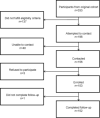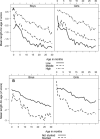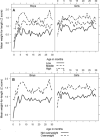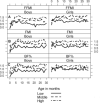Early anthropometric indices predict short stature and overweight status in a cohort of Peruvians in early adolescence
- PMID: 22552904
- PMCID: PMC4013683
- DOI: 10.1002/ajpa.22073
Early anthropometric indices predict short stature and overweight status in a cohort of Peruvians in early adolescence
Abstract
While childhood malnutrition is associated with increased morbidity and mortality, less well understood is how early childhood growth influences height and body composition later in life. We revisited 152 Peruvian children who participated in a birth cohort study between 1995 and 1998, and obtained anthropometric and bioimpedance measurements 11-14 years later. We used multivariable regression models to study the effects of childhood anthropometric indices on height and body composition in early adolescence. Each standard deviation decrease in length-for-age at birth was associated with a decrease in adolescent height-for-age of 0.7 SD in both boys and girls (all P < 0.001) and 9.7 greater odds of stunting (95% CI 3.3-28.6). Each SD decrease in length-for-age in the first 30 months of life was associated with a decrease in adolescent height-for-age of 0.4 in boys and 0.6 standard deviation in girls (all P < 0.001) and with 5.8 greater odds of stunting (95% CI 2.6-13.5). The effect of weight gain during early childhood on weight in early adolescence was more complex to understand. Weight-for-length at birth and rate of change in weight-for-length in early childhood were positively associated with age- and sex-adjusted body mass index and a greater risk of being overweight in early adolescence. Linear growth retardation in early childhood is a strong determinant of adolescent stature, indicating that, in developing countries, growth failure in height during early childhood persists through early adolescence. Interventions addressing linear growth retardation in childhood are likely to improve adolescent stature and related-health outcomes in adulthood.
Copyright © 2012 Wiley Periodicals, Inc.
Figures






Similar articles
-
Undernutrition among Bedouin Arab children: a follow-up of the Bedouin Infant Feeding Study.Am J Clin Nutr. 1995 Mar;61(3):495-500. doi: 10.1093/ajcn/61.3.495. Am J Clin Nutr. 1995. PMID: 7872212
-
Undernutrition in early life and body composition of adolescent males from a birth cohort study.Br J Nutr. 2007 May;97(5):949-54. doi: 10.1017/S0007114507433025. Br J Nutr. 2007. PMID: 17408527
-
Height Trajectory During Early Childhood Is Inversely Associated with Fat Mass in Later Childhood in Mexican Boys.J Nutr. 2019 Nov 1;149(11):2011-2019. doi: 10.1093/jn/nxz157. J Nutr. 2019. PMID: 31334762 Free PMC article.
-
Revisiting the relationship of weight and height in early childhood.Adv Nutr. 2012 Mar 1;3(2):250-4. doi: 10.3945/an.111.001099. Adv Nutr. 2012. PMID: 22516736 Free PMC article. Review.
-
Childhood growth and chronic disease: evidence from countries undergoing the nutrition transition.Matern Child Nutr. 2005 Jul;1(3):177-84. doi: 10.1111/j.1740-8709.2005.00021.x. Matern Child Nutr. 2005. PMID: 16881898 Free PMC article. Review.
Cited by
-
Stunting at birth: recognition of early-life linear growth failure in the western highlands of Guatemala.Public Health Nutr. 2015 Jul;18(10):1737-45. doi: 10.1017/S136898001400264X. Public Health Nutr. 2015. PMID: 26017476 Free PMC article.
-
Dynamic prediction in functional concurrent regression with an application to child growth.Stat Med. 2018 Apr 15;37(8):1376-1388. doi: 10.1002/sim.7582. Epub 2017 Dec 11. Stat Med. 2018. PMID: 29230836 Free PMC article.
-
Growth Velocity and Nutritional Status in Children Exposed to Zika Virus during Pregnancy from Amazonas Cohort, Brazil.Viruses. 2023 Mar 1;15(3):662. doi: 10.3390/v15030662. Viruses. 2023. PMID: 36992371 Free PMC article.
-
Food groups intake in relation to stunting among exceptional children.BMC Pediatr. 2020 Aug 20;20(1):394. doi: 10.1186/s12887-020-02291-7. BMC Pediatr. 2020. PMID: 32819323 Free PMC article.
-
Risk factors of stunting among children living in an urban slum of Bangladesh: findings of a prospective cohort study.BMC Public Health. 2018 Jan 30;18(1):197. doi: 10.1186/s12889-018-5101-x. BMC Public Health. 2018. PMID: 29378556 Free PMC article.
References
-
- Adair LS, Cole TJ. Rapid child growth raises blood pressure in adolescent boys who were thin at birth. Hypertension. 2003;41:451–456. - PubMed
-
- Barker DJ, Eriksson JG, Forsen T, Osmond C. Fetal origins of adult disease: strength of effects and biological basis. Int J Epidemiol. 2002;31:1235–1239. - PubMed
-
- Barker DJ, Osmond C, Forsen TJ, Kajantie E, Eriksson JG. Trajectories of growth among children who have coronary events as adults. N Engl J Med. 2005;353:1802–1809. - PubMed
Publication types
MeSH terms
Grants and funding
LinkOut - more resources
Full Text Sources
Medical

